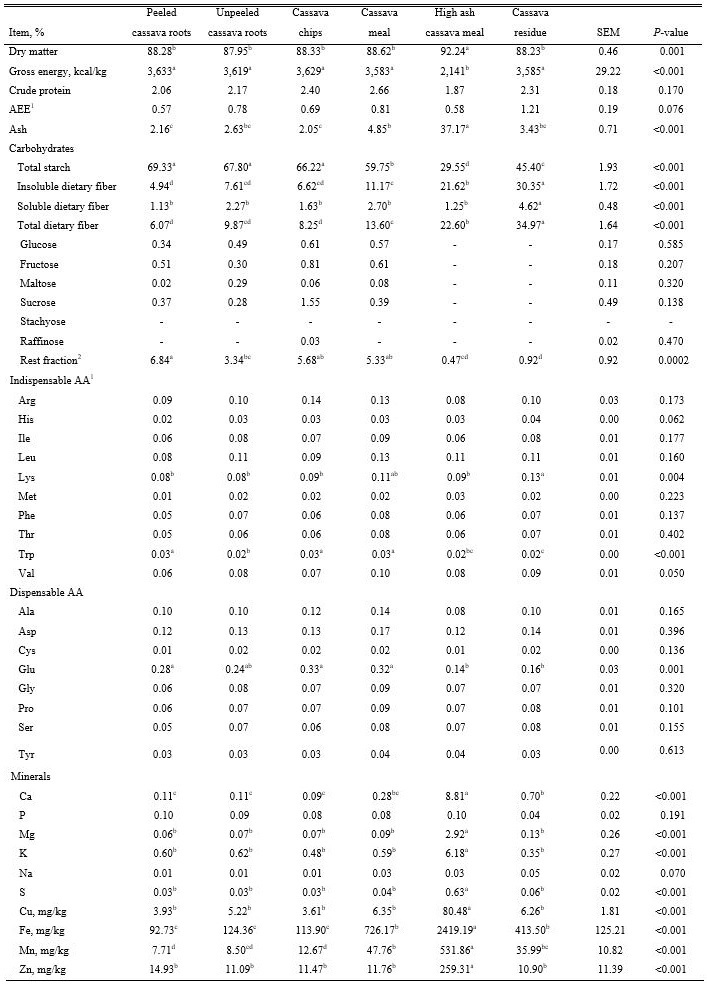Cassava, also known as manioc, tapioca, or yucca, is a starchy tuber crop grown in tropical and subtropical regions. Peeled cassava is obtained after the tubers have been water-cleaned and mechanically peeled. Cassava chips are chopped cassava roots that have been sun-dried or artificially dried and can be produced in a variety of shapes and sizes. Cassava chips may be sold directly, ground into cassava meal, or pelleted. The solid fibrous residue of cassava (i.e., cassava residue) represents the remaining residue after most of the starch has been extracted to produce cassava flour. Cassava can be used as an alternative ingredient in animal feed to provide energy; however, limited information about the chemical composition of different sources of cassava-based feed ingredients is available. Therefore, the objectives of this study were to determine the chemical composition of different cassava-based feed ingredients and test the hypothesis that there is variation in chemical composition among cassava products.
Experimental Procedure
All cassava ingredients used in this experiment were obtained from South-East Asian suppliers. Sources of cassava products included three samples of dried peeled cassava roots from the Philippines and Thailand, three samples of dried unpeeled cassava roots from the Philippines and Vietnam, six samples of cassava chips from Thailand and Vietnam, two samples of cassava meal from Thailand, two samples of high ash cassava meal from Indonesia, and six samples of cassava residue from Indonesia and Vietnam. All samples were analyzed for dry matter, gross energy, nitrogen, amino acids (AA), acid hydrolyzed ether extract, ash, minerals, total starch, insoluble dietary fiber, and soluble dietary fiber. Samples of peeled and unpeeled cassava roots, cassava chips, and cassava meal were also analyzed for sugars. The rest fraction for each cassava product was calculated, and statistical analysis were performed to test differences among ingredients.
Results
High ash cassava meal had greater (P < 0.05) dry matter and ash, but lower (P < 0.05) total starch and gross energy than all other cassava products (Table 1). Cassava meal had greater (P < 0.05) concentration of ash than peeled cassava roots and cassava chips. Peeled cassava roots, unpeeled cassava roots, and cassava chips had greater (P < 0.05) total starch compared with the other cassava ingredients. Cassava residue had greater (P < 0.05) Lys, insoluble dietary fiber, soluble dietary fiber, and total dietary fiber concentrations compared with the other cassava products, but Trp and Glu were greater (P < 0.05) in peeled cassava roots, cassava chips, and cassava meal samples compared with the other ingredients. There were no differences in crude protein and acid hydrolyzed fat among cassava co-products. There were also no differences in the concentration of sugars and oligosaccharides among peeled cassava roots, unpeeled cassava roots, cassava chips, and cassava meal. Concentration of most minerals was greater (P < 0.05) in high ash cassava meal than in the other cassava products. However, no differences between P and Na among the analyzed cassava based co-products were observed.
Key points
- The chemical composition of all cassava-based products confirms that cassava is a high starch, low crude protein, and a low fat ingredient.
- The analyzed components of unpeeled cassava roots, high ash cassava meal, and cassava residue were close to 100%, indicating that all nutrients in these ingredients were accounted for.
- Nutrient composition was not different in dried peeled cassava roots from the Philippines and Thailand and in dried unpeeled cassava roots from the Philippines and Vietnam. Nutrient composition of cassava chips from Thailand was also not different from that of chips from Vietnam.
- Cassava residue samples from Indonesia, Thailand, and Vietnam had high concentration of total dietary fiber, making this ingredient more suitable for ruminants and sows than for younger pigs or poultry.
- Cassava-based ingredients sold as peeled roots, unpeeled roots, chips, or meal have chemical compositions that are not different, and it is possible that the manufacturing processes are similar, but different companies market the products under different names.
- Peeling has little impact on chemical composition of cassava co-products.
- High ash cassava meal has lower nutritional quality compared with other cassava products due to low starch and gross energy.
Table 1. Comparison of chemical composition of cassava-based feed ingredients

1 AEE = acid hydrolyzed ether extract; AA + amino acids.
2 Rest fraction + calculated using the following equation: [Dry matter - (crude protein + AEE + ash + total dietary fiber + total starch + glucose + fructose + maltose + sucrose + stachyose + raffinose)]. The rest fraction for high ash cassava meal and cassava residue was calculated using the same equation, with the exception that sugars were not analyzed in these samples.
a-d Mean in a row without a common superscript letter differ (P < 0.05).